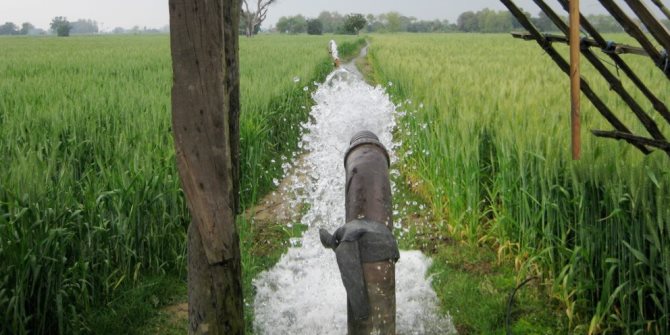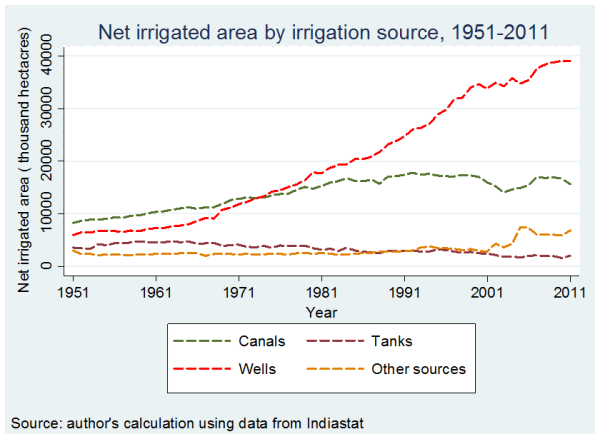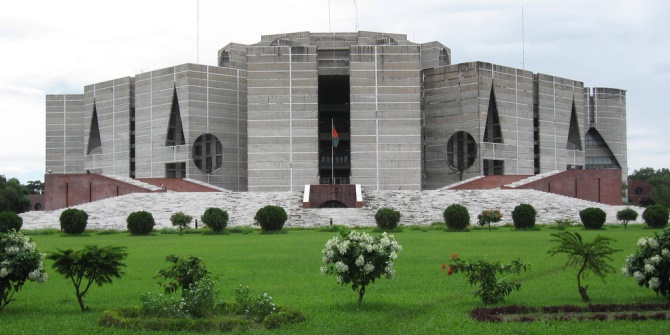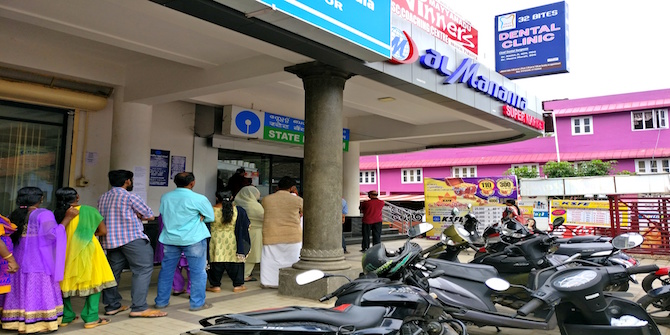 Today 61% of irrigated areas in India rely on groundwater, placing supplies under great stress. Sudhanshu Sharma argues this is largely due to policies which incentivise farmers to pump unsustainable amounts of groundwater, designed by politicians targeting farmer votes. He writes that, although solutions to the problem of dwindling groundwater have been proposed and even trialled, they are most likely to fail because they underestimate the political dimension of the problem.
Today 61% of irrigated areas in India rely on groundwater, placing supplies under great stress. Sudhanshu Sharma argues this is largely due to policies which incentivise farmers to pump unsustainable amounts of groundwater, designed by politicians targeting farmer votes. He writes that, although solutions to the problem of dwindling groundwater have been proposed and even trialled, they are most likely to fail because they underestimate the political dimension of the problem.
With 5,102 dams, India is the third most dammed country in the world. Jawaharlal Nehru, India’s first prime minister, referred to dams as “temples of modern India”. While planning India’s post-independence growth story, it was envisaged that dams will be the mainstay of irrigation for agriculture which was otherwise reliant on rainfall and vulnerable to the vagaries of monsoons. The reality did not turn out that way. The graph below shows the evolution of net irrigated area by irrigation source during the period 1951-2011. Dams, and their associated network of canals canals, were key source of irrigation until the early 1970s. The mid-1970s saw a shift towards groundwater, exploited through wells and tube-wells, as a major source of irrigation.
To put things in context, in the year 2011, 61% of the net irrigated area was irrigated using groundwater whereas only 24% was irrigated using canals. The dramatic rise in India’s reliance on groundwater for irrigation can be partly explained as a response to deteriorating condition of canal irrigation infrastructure which led to decline in quality and availability of water. Using groundwater for irrigation has helped address the problems of water logging and salinity in river basins, and it is also a more reliable water source, further protecting farmers from unreliable monsoon rains. The other-and inherently more complex- part of the explanation of the phenomenon pertains to the political economy of irrigation in India which is the focus of this article.
Water-energy nexus:
It’s not a coincidence that the steep rise in use of groundwater for irrigation followed the large-scale electrification of villages. Access to electricity, energy subsidies and affordable pumps allowed farmers to shift their dependence from surface irrigation (via canals) to groundwater (via wells and tube-wells). In principle, these developments empowered farmers by diversifying their irrigation options and insuring them against the rain shocks. However, the absence of a robust water management policy left the groundwater resources vulnerable to over-exploitation. Today, more than 70% of the groundwater has already been utilised (Sinha, 2005) and the available groundwater resources are under great stress. This raises serious questions around agricultural sustainability and, as a consequence, on food security in India. The water-energy nexus can be analysed from two interlinked perspectives: (i) policies creating perverse incentives and (ii) politics of such policies
Creating perverse incentives:
A key insight from the discipline of economics is that agents respond to incentives. In the wake of independence, some well-intentioned but short-sighted interventions in energy and agricultural policy created incentives for farmers to over-exploit groundwater. Let’s begin with energy policy. Until the 1970s agricultural consumers were billed according to their electricity usage. However the sparse nature of agricultural pumps in rural India implied higher transaction costs for electricity providers who decided to shift to load-based tariff. Now the electricity bill became the function of the number and power-capacity of pumps and not actual usage. It’s not surprising that farmers took to gross underreporting of the number of pumps to reduce electricity bills, leading to commercial losses for electricity providers. As the financial bottom lines of electricity companies were hit, the quality and availability of electricity in rural India deteriorated. The uncertainty of electricity supply further induced farmers to use their pumps continuously, whenever electricity became available, without the concern for the sustainability of groundwater resources.
On the agricultural policy front, food subsidies in the form of the Minimum Support Price (MSP) heavily focus on procurement of two food grains, namely wheat and rice. This distorted the cropping patterns and incentivised farmers to focus disproportionately on those two crops. Both rice and wheat are water-intensive crops and the farmers who shifted to growing these crops, in hope of higher returns, had no choice but to resort to extensive use of groundwater for irrigation.

Politics of perverse incentives:
The inertia to change inefficient policies often arises from political processes driven by self-interest. Farmers form an important vote bank for politicians especially in the farming intensive states of Punjab, Haryana, Tamil Nadu, Andhra Pradesh, Uttar Pradesh and Bihar. Giving sops to farmers, clothed in the rhetoric of farmer welfare, is an old gimmick of political populism in India. For example, in 1970s following famer movements in many parts of India the state governments relented by giving highly subsidized electricity tariff for farmers. Many states, starting with Andhra Pradesh, gave free electricity for agriculture sector. This not only created further perverse incentives for misuse of resources for farmers, it also reinforced their belief that they can lobby with the government against the change in status-quo. The subsidised or free electricity led to over-exploitation of groundwater, which is evident in the critically low levels of groundwater in Punjab, Haryana and other farming states. Additionally, the benefits of cheap or free electricity are not equitably distributed and often disproportionately benefit the rich farmers who can afford multiple pumps and tube wells. It’s not a surprise that this has led to a creation of informal groundwater markets in many parts of India where the rich farmers rent out water from pumps to poor farmers. The quid-pro-quo between rent seeking politicians and organised farmer lobbies makes the water-energy nexus more resolute.
No easy answers:
Economics has classic textbook solutions to address the inefficiencies created by the water-energy nexus in irrigation: rationalisation of electricity tariff, improved metering of pumps, the (phased) rollout of energy and food subsidies. These solutions -many of which have already been tried- are most likely to fail because they underestimate the political dimension of the problem. There are no easy solutions to the challenges posed by the water-energy nexus, but any realistic and effective solution would have to factor in the political milieu and its constraints. A possible way forward would be to design policies which align the interests of farmers, and thus indirectly politicians’, with prudent groundwater management, although the likelihood is even this would be easier said than done.
Note: This article gives the views of the author, and not the position of the South Asia @ LSE blog, nor of the London School of Economics. Please read our comments policy before posting.
About the Author
 Sudhanshu Sharma holds an MPA in Public and Economic Policy from LSE, where he was a Research Assistant at Department of Sociology & STICERD and a Capstone Consultant to the Department for International Development (DFID). His areas of interests are political economy and economic development. He is a reviewer at LSE Review of Books and is currently involved in an impact evaluation project in rural Tamil Nadu, India.
Sudhanshu Sharma holds an MPA in Public and Economic Policy from LSE, where he was a Research Assistant at Department of Sociology & STICERD and a Capstone Consultant to the Department for International Development (DFID). His areas of interests are political economy and economic development. He is a reviewer at LSE Review of Books and is currently involved in an impact evaluation project in rural Tamil Nadu, India.








